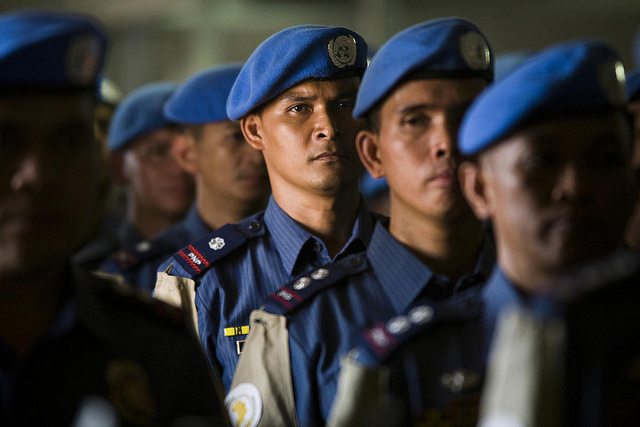Philippine defense secretary Voltaire Gazmin and Japanese ambassador to the Philippines Kazuhide Ishikawa on February 29 signed a new defense agreement to allow the transfer of defense equipment and technology from Japan to the Philippines. It also provides for the Philippines and Japan to conduct joint research and development, and even joint production, of defense equipment and technology. The agreement stipulates the formation of a Philippine-Japan joint committee that will manage the transfer of defense equipment and technology, as well as how the materiel and know-how can be used. Both parties expect that the agreement will not only enhance their evolving security partnership but also help Japan further develop the production and technological bases for its growing defense industry.
Japan has similar defense agreements with the United States and Australia. This pact, however, is its first with a fellow East Asian country—and one that, like Japan, is embroiled in a territorial dispute with China. The negotiations leading to the agreement were first disclosed to the public when President Benigno Aquino and Prime Minister Shinzo Abe met on November 17, 2015, on the sidelines of the Asia-Pacific Economic Cooperation (APEC) leaders’ meeting in Manila. Both concurred that the agreement would not include specifics about the type of security assistance to be offered.
Upon signing the agreement, Secretary Gazmin did not mention any specific defense equipment to be transferred by Japan, but he did say that the Armed Forces of the Philippines (AFP) needs to upgrade its intelligence, surveillance, and reconnaissance capabilities. The Asahi Shimbun revealed that Japan plans to provide the Philippines with five second-hand Beechcraft TC-90 King Air reconnaissance planes currently used by the Japan Maritime Self-Defense Force (JMSDF) for training, which can be equipped with basic surface and air-surveillance radar. These short-range reconnaissance aircraft will enable the Philippine Navy to patrol the disputed waters of the South China Sea. The Philippines has also expressed interest in the purchase of other Japanese-made defense equipment. Early last year, Philippine defense officials raised the prospect of acquiring surplus P-3C Orion long-range reconnaissance planes and even submarines from Japan. An anonymous Philippine defense official recently said that this new security accord, “opens the door to a lot of opportunities beyond the confines of mere equipment transfer or sale.”
Sense of Urgency
It is interesting that the agreement took only three months to negotiate. This reflected a sense of urgency by both parties to have the new pact signed to pave the way for Japan to donate used military equipment, transfer technology, and extend security training to the AFP. The Aquino administration in 2011 decided to build up the AFP’s capabilities to accomplish a very modest goal—the development of a competent force capable of defending the Philippines’ interests and the land features it occupies in the South China Sea. This will require the AFP to acquire the following capabilities:
- Effective forces in the South China Sea and nearby coastal areas with the competence to defend Philippine territory; and
- Greater surveillance and monitoring to secure Philippine islands and prevent unoccupied islands/reefs from being occupied by other claimants.
Despite these unambitious objectives, the Aquino administration is still immobilized by scant financial resources. Consequently, the Philippines has turned to both the United States and Japan as it modernizes its ill-equipped navy and air force.
Japan, meanwhile, is alarmed by the long-term implications of China’s island-building activities in the South China Sea. In late 2015, Tokyo considered expanding JMSDF surveillance operations in the South China Sea. During the APEC leaders’ meeting in November, Prime Minister Abe announced that Japan was considering joining the United States and possibly other partners in joint patrols in disputed waters of the South China Sea, though domestic opposition seems to have forced him to back away from that. Japan has since announced that forces returning from anti-piracy missions in the Gulf of Aden would engage in surveillance patrols while passing through the South China Sea. Meanwhile Tokyo has continued to explore ways to expand its security cooperation with other Asian countries as an alternative to more direct action by Japanese forces.
Enhancing the Strategic Partnership
Secretary Gazmin insisted that the new agreement between Japan and the Philippines is not directed against any country and aims only to address strategic gaps in the underfunded AFP. But the agreement is a clear indication of the increasing level of security cooperation between Manila and Tokyo in the face of China’s expansive claims and the build-up of its naval and paramilitary capabilities.
The historic change in the direction of Philippines-Japan security relations became apparent when the two countries’ signed the 2012 Statement of Intent on Defense Cooperation Exchanges, held joint naval search and rescue drills in the South China Sea in mid-2015, and began exploring the prospect of a status of forces agreement that would allow Japanese forces to conduct larger military exercises with the AFP in the Philippines. Two days after Secretary Gazmin and Ambassador Ishikawa signed the new defense agreement, two JMSDF ships—the Uraga and Takashina—docked in Manila Bay for a three-day goodwill visit to the Philippines. The Asahi Shimbun recently reported that in early April two JMFDF destroyers and a Japanese submarine—the first to visit the Philippines in 15 years—will make a port call at Subic Bay.
The signing of the agreement on the transfer of defense equipment and technology between the Philippines and Japan and the increasing frequency of JMSDF ship visits are signs that Japan is determined to cooperate more closely with Southeast Asian states on maritime security in order to balance China’s efforts to enforce its expansive maritime claims in the South China Sea.
